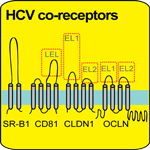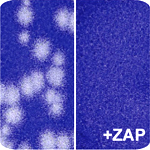Laboratory of Virology and Infectious Disease

Membrane topologies of known HCV co-receptors: SR-BI, CD81, CLDN1 and OCLN.

ZAP is a cellular protein that inhibits plaque formation by Sindbis virus.
Virus Entry and Virus-Host Interactions
Viruses are absolutely dependent on a host cell for their replication. The identification of host factors that interact with viral proteins, bind to the viral genome, or orchestrate essential steps in the virus life cycle can suggest targets for antiviral drugs. Binding of a virion to its receptor(s) on the outside of the target cell is the first critical virus-host interaction. We have recently discovered two new HCV co-receptors, the tight junction proteins claudin-1 (CLDN1) and occludin (OCLN). These molecules join two previously known entry factors - CD81 and scavenger receptor B1 (SR-BI). Current work is aimed at understanding how HCV uses these four co-receptors to gain access to the interior of the cell. We have found that uptake involves endocytosis followed by low-pH dependent fusion, and that unknown factors must prime virions to undergo this process. Elucidating these first steps of HCV infection may help with the design of entry inhibitors and will assist in the development of small animal models.
Just as viruses commandeer cellular factors to perform essential roles in their life cycles, cells have evolved proteins capable of targeting an invading pathogen. The mammalian zinc-finger antiviral protein (ZAP) is one such host defense molecule that can stop some viruses in their tracks. Research Associate Professor Margaret R. MacDonald leads investigations into the mechanisms by which ZAP inhibits Sindbis virus, a member of the family Togaviridae. Recent work has shown that two or more ZAP proteins work together to block translation of the incoming Sindbis genome. We have also found that factors involved in cellular stress (G3BP1 and G3BP2) can interact with the Sindbis replication machinery and limit viral polyprotein expression. We are continuing to search for new antiviral proteins that may one day be exploited for drug development.
Further reading
- Ploss A, Evans MJ, Gaysinskaya VA, Panis M, You H, de Jong YP, Rice CM. Human occludin is a hepatitis C virus entry factor required for infection of mouse cells. Nature. 2009 Feb 12;457(7231):882-6.
- Evans MJ, von Hahn T, Tscherne DM, Syder AJ, Panis M, Wölk B, Hatziioannou T, McKeating JA, Bieniasz PD, Rice CM. Claudin-1 is a hepatitis C virus co-receptor required for a late step in entry. Nature. 2007 Apr 12;446(7137):801-5.
- Law LM, Albin OR, Carroll JW, Jones CT, Rice CM, MacDonald MR. Identification of a dominant negative inhibitor of human zinc finger antiviral protein reveals a functional endogenous pool and critical homotypic interactions. J Virol. 2010 May;84(9):4504I-12.
- Cristea IM, Rozjabek H, Molloy KR, Karki S, White LL, Rice CM, Rout MP, Chait BT, MacDonald MR. Host factors associated with the Sindbis virus RNA-dependent RNA polymerase: a role for G3BP1 and G3BP2 in virus replication. J Virol. 2010 Apr 14
